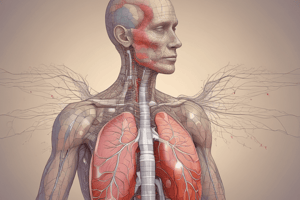Podcast
Questions and Answers
What is the main function of the respiratory system?
What is the main function of the respiratory system?
- To provide the body with oxygen and remove carbon dioxide (correct)
- To regulate body temperature
- To pump blood to the entire body
- To aid in digestion
Which muscle is responsible for the initial phase of inhaling air?
Which muscle is responsible for the initial phase of inhaling air?
- Trapezius
- Diaphragm (correct)
- Rectus abdominis
- Serratus anterior
Where does the exchange of oxygen and carbon dioxide take place in the respiratory system?
Where does the exchange of oxygen and carbon dioxide take place in the respiratory system?
- Bronchi
- Pharynx
- Alveoli (correct)
- Trachea
What is the function of the cilia in the trachea and bronchi?
What is the function of the cilia in the trachea and bronchi?
What initiates the exhaling process in the respiratory system?
What initiates the exhaling process in the respiratory system?
Which respiratory disease causes the airways to narrow, making it difficult to breathe?
Which respiratory disease causes the airways to narrow, making it difficult to breathe?
What is the function of the respiratory system related to regulating body temperature?
What is the function of the respiratory system related to regulating body temperature?
Which respiratory disorder is characterized by an inflammation of the lining of the lungs, causing sharp pain with each breath?
Which respiratory disorder is characterized by an inflammation of the lining of the lungs, causing sharp pain with each breath?
In which respiratory disease does the infection cause inflammation in the alveoli, making it difficult for oxygen to enter the bloodstream?
In which respiratory disease does the infection cause inflammation in the alveoli, making it difficult for oxygen to enter the bloodstream?
Which respiratory system function involves providing the body with oxygen and removing carbon dioxide?
Which respiratory system function involves providing the body with oxygen and removing carbon dioxide?
Flashcards are hidden until you start studying
Study Notes
Respiratory System
The respiratory system is a vital organ system in the human body responsible for the process of inhaling and exhaling air. It consists of the nose, pharynx, larynx, trachea, bronchi, lungs, and diaphragm. The main function of the respiratory system is to provide the body with the oxygen it needs to survive and remove carbon dioxide, a waste product of cellular metabolism.
Mechanics of Breathing
The mechanics of breathing involve the coordinated movement of several muscles and organs. The process begins with the contraction of the diaphragm, a large muscle located at the base of the lungs, which pulls down on the lungs and increases the volume of the thoracic cavity. This creates a negative pressure, which draws air into the lungs through the nose or mouth.
As the air enters the lungs, it passes through the trachea and bronchi, which are lined with tiny hair-like structures called cilia that help to filter out any foreign particles. The air then enters the alveoli, small air sacs where the exchange of oxygen and carbon dioxide takes place. Oxygen from the air diffuses into the bloodstream, while carbon dioxide diffuses out of the blood and into the alveoli to be exhaled.
The exhaling process is initiated by the relaxation of the diaphragm, which allows the lungs to return to their normal size and pressure, pushing the air out of the lungs.
Respiratory System Diseases
There are several diseases that can affect the respiratory system, including pneumonia, asthma, and chronic obstructive pulmonary disease (COPD). Pneumonia is an infection that causes inflammation in the alveoli, making it difficult for oxygen to enter the bloodstream. Asthma is a chronic condition that causes the airways to narrow, making it difficult to breathe. COPD is a progressive disease that causes the airways to become damaged and scarred, making it difficult to exhale.
Common Respiratory Disorders
Common respiratory disorders include bronchitis, emphysema, and pleurisy. Bronchitis is an inflammation of the bronchi, which can cause coughing, wheezing, and shortness of breath. Emphysema is a condition that causes the alveoli to become damaged and rupture, making it difficult for the lungs to exhale. Pleurisy is an inflammation of the lining of the lungs, which can cause sharp pain with each breath.
Respiratory System Functions
The respiratory system has several important functions, including:
- Providing the body with oxygen: The respiratory system is responsible for delivering oxygen to the body's cells, where it is used for cellular respiration.
- Removing carbon dioxide: The respiratory system also removes carbon dioxide, a waste product of cellular metabolism, from the body.
- Regulating body temperature: The process of breathing helps to regulate body temperature by bringing warm air into the body and expelling cool air.
- Speech: The respiratory system plays a role in speech by providing the air pressure needed to produce sound.
- Smell: The respiratory system also plays a role in the sense of smell by allowing air to enter the nasal cavity, where it comes into contact with olfactory receptors.
In conclusion, the respiratory system is a complex organ system that plays a crucial role in the health and well-being of the human body. Understanding the mechanics of breathing, common respiratory disorders, and the functions of the respiratory system can help individuals to maintain good respiratory health and seek appropriate medical attention when necessary
Studying That Suits You
Use AI to generate personalized quizzes and flashcards to suit your learning preferences.





